A Deep Learning Technique to Improve Road Maintenance Systems Based on Climate Change
Abstract
1. Introduction
1.1. Effects of Climate Change on Road Systems
1.2. Contributions
- The proposed RMSDC architecture is innovative for multivariate time-series interpretability in road maintenance, particularly for multiple time-step forecasts.
- The spatial and temporal attention mechanisms are jointly trained in a unified design to learn the temporal and spatial contributions. The domain knowledge for the Road Maintenance dataset is utilized to explain the learned interpretations.
- RMSDC achieves state-of-the-art prediction accuracy while remaining interpretable. In most evaluations, RMSDC outperforms the baseline models, while in a few instances it matches the forecast accuracy of the baseline models.
2. Related Work
3. Theory and Methods
3.1. Time-Series and Automated Statistical Downscaling (ADS)
3.2. Time Series Analysis Using Convolutional Neural Networks (CNNs)
3.3. RNNs for Time Series
3.4. Time Series Analysis Using Long Short-Term Memory (LSTM) Networks
3.5. Convolutional LSTM Networks
4. RMSDC Technique Based on Multivariate Classification for Road Maintenance Systems and Climate Change
Dataset
- Day: The measurement was taken on this day.
- Time (+01:00): The measurement time is adjusted for the local time zone (+01:00). S1–S3: Road surface condition measurements from three distinct sensors (S1, S2, and S3)
- Friction: A measurement of the friction coefficient of the road surface, which indicates how slippery the road is, with 0.1–0.81 as the measured friction value.
- Ta: The air temperature at the time and place of measurement.
- S7: A sensor measurement of the road surface’s moisture content.
- Tsurf: The road’s surface temperature at the time and location of measurement.
- S9–S11: Road surface condition measurements from three distinct sensors (S9, S10, and S11)
- Water: The amount of water on the road’s surface at the time and location of meas urement.
- Speed: The vehicle’s speed at the time and location of the measurement.
- The direction in which the vehicle was traveling at the time the measurement was taken.
- The latitude of the site where the measurement was taken.
- The longitude of the site where the measurement was made.
- Height: The elevation above sea level where the measurement was taken.
- Accuracy: The GPS measurement’s precision.
- Tdew: The temperature at the dew point at the time and location of measurement.
- Friction 2: A second measure of the friction coefficient of the road surface that may be measured with a different method or sensor.
- Distance: The distance the vehicle has traveled since the previous measurement.
- Serial (RCM411): The serial number or identifier of the data collection device (data logger).
- State: is a categorical variable that indicates the overall condition of the road surface—Dry, Moist, Wet, Icy, Snowy, and Slushy—with values from 1–6.
5. Experiments and Discussion
5.1. Evaluation Metrics
- Mean Absolute Error (MAE): MAE calculates the average absolute difference between the predicted and actual values. It is commonly employed for time series forecasting and regression tasks.
- Root-Mean-Square Error (RMSE): RMSE computes the square root of the average squared difference between the predicted and actual values. It is similar to MAE but gives more weight to significant errors.
- Precision and Recall: Precision and recall are valuable metrics for evaluating classification models. Precision measures the proportion of true positive predictions among all positive predictions, while recall gauges the proportion of true positive predictions among all actual positive cases.
5.2. Performance Analysis and Implementation
5.3. Results
6. Conclusions
7. Limitations and Future Works
Author Contributions
Funding
Institutional Review Board Statement
Informed Consent Statement
Data Availability Statement
Acknowledgments
Conflicts of Interest
References
- Mann, M.E.; Rahmstorf, S.; Kornhuber, K.; Steinman, B.A.; Miller, S.K.; Coumou, D. Influence of Anthropogenic Climate Change on Planetary Wave Resonance and Extreme Weather Events. Nat. Sci. Rep. 2017, 7, 45242. [Google Scholar] [CrossRef] [PubMed]
- The World Bank. Climate and Disaster Resilient Transport in Small Island Developing States: A Call for Action; World Bank: Washington, DC, USA, 2017. [Google Scholar]
- Conell, J. Vulnerable Islands: Climate Change, Tectonic Change, and Changing Livelihoods in the Western Pacific. In The Contemporary Pacific; University of Hawaii Press: Honolulu, HI, USA, 2015; Volume 27. [Google Scholar]
- The Government of the Republic of Fiji. The World Bank Climate Vulnerability Assessment—Making Fiji Climate Resilient; The Government of the Republic of Fiji: Suva, Fiji, 2017.
- Mnih, V.; Kavukcuoglu, K.; Silver, D.; Rusu, A.A.; Veness, J.; Bellemare, M.G.; Graves, A.; Riedmiller, M.; Fidjeland, A.K.; Ostrovski, G.; et al. Human-level control through deep reinforcement learning. Nature 2015, 518, 529–533. [Google Scholar] [CrossRef] [PubMed]
- United Nations UN and Climate Change, the Science, Website. Available online: https://www.un.org/climatechange/the-science/index.html (accessed on 14 February 2018).
- NASA Global Climate Change, Vital Signs of the Planet, Website. Available online: https://climate.nasa.gov (accessed on 14 February 2018).
- NASA Global Climate Change, Vital Signs of the Planet: Effects, Website. Available online: https://climate.nasa.gov/effects/ (accessed on 14 February 2018).
- Field, C.B.; Barros, V.R. Summary for policymakers. In Climate Change 2014: Impacts, Adaptation, and Vulnerability; Part A: Global and Sectoral Aspects. Contribution of Working Group II to the Fifth Assessment Report of the Intergovernmental Panel on Climate Change; IPCC Cambridge University Press: Cambridge, UK; New York, NY, USA, 2014; pp. 1–32. [Google Scholar]
- Drees-Gross, F.; Ijjasz-Vasquez, E. Resilient Transport Investments: A climate Imperative for Small Island Developing Countries Transport for Development Blog, The World Bank, Website. Available online: https://blogs.worldbank.org/transport/resilient-transport-investments-climate-imperative-small-island-developing-countries (accessed on 25 April 2018).
- COP22 Declaration on Accelerating Action on Transport Adaptation, Resilient Transport in a Changing Climate Paris Process on Mobility and Climate, Website. Available online: http://www.ppmc-transport.org/wp-content/uploads/2016/11/COP-22-Declaration-on-Accelerated-Action-on-Adaptation-in-Transport.pdf (accessed on 25 April 2018).
- International Transport Forum. Adapting Transport Infrastructure to Climate Change OECD/ITF; International Transport Forum: Paris, France, 2015. [Google Scholar]
- Climate Change Impacts, Climate Impacts on Transportation US Environmental Protection Agency, Website. Available online: https://19january2017snapshot.epa.gov/climate-impacts/climate-impacts-transportation_.html (accessed on 25 April 2018).
- Santero, N.J.; Horvath, A. Global warming potential of pavements. Environ. Res. Lett. 2009, 4, 034011. [Google Scholar] [CrossRef]
- Cartwright, E.D. Code Red—Recent IPCC Report Warns Time is Running Out on Climate Change. Clim. Energy 2021, 38, 11–12. [Google Scholar] [CrossRef]
- Wang, H.; Gangaram, R. Life Cycle Assessment of Asphalt Pavement Maintenance, Rutgers University; Center for Advanced Infrastructure and Transportation: Piscataway, NJ, USA, 2014. [Google Scholar]
- Pellicer, E.; Sierra, L.A.; Yepes, V. Appraisal of infrastructure sustainability by graduate students using an active-learning method. J. Clean. Prod. 2016, 113, 884–896. [Google Scholar] [CrossRef]
- Santos, J.; Torres-Machi, C.; Morillas, S.; Cerezo, V. A fuzzy logic expert system for selecting optimal and sustainable life cycle maintenance and rehabilitation strategies for road pavements. Int. J. Pavement Eng. 2020, 23, 425–437. [Google Scholar] [CrossRef]
- Watts, N.; Amann, M.; Arnell, N.; Ayeb-Karlsson, S.; Belesova, K.; Berry, H.; Bouley, T.; Boykoff, M.; Byass, P.; Cai, W.; et al. The 2018 report of the Lancet Countdown on health and climate change: Shaping the health of nations for centuries to come. Lancet 2018, 392, 2479–2514. [Google Scholar] [CrossRef]
- France-Mensah, J.; O’Brien, W.J. Budget allocation models for pavement maintenance and rehabilitation: Comparative case study. J. Manag. Eng. 2018, 34, 05018002. [Google Scholar] [CrossRef]
- Yu, B.; Gu, X.; Ni, F.; Guo, R. Multi-objective optimization for asphalt pavement maintenance plans at project level: Integrating performance, cost and environment. Transp. Res. Part D Transp. Environ. 2015, 41, 64–74. [Google Scholar] [CrossRef]
- Piryonesi, S.M.; El-Diraby, T.E. Data analytics in asset management: Cost-effective prediction of the pavement condition index. J. Infrastruct. Syst. 2020, 26, 04019036. [Google Scholar] [CrossRef]
- Yamany, M.S.; Saeed, T.U.; Volovski, M.; Ahmed, A. Characterizing the performance of interstate flexible pavements using artificial neural networks and random parameters regression. J. Infrastruct. Syst. 2020, 26, 04020010. [Google Scholar] [CrossRef]
- Torres-Machi, C.; Pellicer, E.; Yepes, V.; Chamorro, A. Towards a sustainable optimization of pavement maintenance programs under budgetary restrictions. J. Clean. Prod. 2017, 148, 90–102. [Google Scholar] [CrossRef]
- Osorio-Lird, A.; Chamorro, A.; Videla, C.; Tighe, S.; Torres-Machi, C. Application of Markov chains and Monte Carlo simulations for developing pavement performance models for urban network management. Struct. Infrastruct. Eng. 2018, 14, 1169–1181. [Google Scholar] [CrossRef]
- Alam, M.R.; Hossain, K.; Bazan, C. A systematic approach to estimate global warming potential from pavement vehicle interaction using Canadian Long-Term Pavement Performance data. J. Clean. Prod. 2020, 273, 123106. [Google Scholar] [CrossRef]
- Huang, M.; Dong, Q.; Ni, F.; Wang, L. LCA and LCCA based multi-objective optimization of pavement maintenance. J. Clean. Prod. 2021, 283, 124583. [Google Scholar] [CrossRef]
- Irfan, M.; Khurshid, M.B.; Bai, Q.; Labi, S.; Morin, T.L. Establishing optimal project-level strategies for pavement maintenance and rehabilitation—A framework and case study. Eng. Optim. 2012, 44, 565–589. [Google Scholar] [CrossRef]
- Donev, V.; Hoffmann, M. Optimisation of pavement maintenance and rehabilitation activities, timing and work zones for short survey sections and multiple distress types. Int. J. Pavement Eng. 2020, 21, 583–607. [Google Scholar] [CrossRef]
- Li, F.; Feng, J.; Li, Y.; Zhou, S. Preventive Maintenance Technology for Asphalt Pavement; Springer: Berlin/Heidelberg, Germany, 2021. [Google Scholar]
- Qiao, J.Y.; Du, R.; Labi, S.; Fricker, J.D.; Sinha, K.C. Policy implications of standalone timing versus holistic timing of infrastructure interventions: Findings based on pavement surface roughness. Transp. Res. Part A Policy Pract. 2021, 148, 79–99. [Google Scholar] [CrossRef]
- Renard, S.; Corbett, B.; Swei, O. Minimizing the global warming impact of pavement infrastructure through reinforcement learning. Resour. Conserv. Recycl. 2021, 167, 105240. [Google Scholar] [CrossRef]
- Neves, A.C.; González, I.; Leander, J.; Karoumi, R. A new approach to damage detection in bridges using machine learning. In Proceedings of the International Conference on Experimental Vibration Analysis for Civil Engineering Structures, San Diego, CA, USA, 12–14 July 2017. [Google Scholar]
- Chopra, P.; Sharma, R.K.; Kumar, M.; Chopra, T. Comparison of machine learning techniques for the prediction of compressive strength of concrete. Adv. Civ. Eng. 2018, 2018, 5481705. [Google Scholar] [CrossRef]
- Deka, P.C. A Primer on Machine Learning Applications in Civil Engineering; CRC Press: Boca Raton, FL, USA, 2019. [Google Scholar]
- Naranjo-Pérez, J.; Infantes, M.; Jiménez-Alonso, J.F.; Sáez, A. A collaborative machine learning-optimization algorithm to improve the finite element model updating of civil engineering structures. Eng. Struct. 2020, 225, 111327. [Google Scholar] [CrossRef]
- Assaad; El-Adaway, I.H. Bridge infrastructure asset management system: Comparative computational machine learning approach for evaluating and predicting deck deterioration conditions. J. Infrastruct. Syst. 2020, 26, 04020032. [Google Scholar] [CrossRef]
- Athanasiou, A.; Ebrahimkhanlou, A.; Zaborac, J.; Hrynyk, T.; Salamone, S. A machine learning approach based on multifractal features for crack assessment of reinforced concrete shells. Comput. Aided Civ. Infrastruct. Eng. 2020, 35, 565–578. [Google Scholar] [CrossRef]
- Azimi, M.; Pekcan, G. Structural health monitoring using extremely compressed data through deep learning. Comput. Aided Civ. Infrastruct. Eng. 2020, 35, 597–614. [Google Scholar] [CrossRef]
- Jiang, S.; Zhang, J. Real-time crack assessment using deep neural networks with wall-climbing unmanned aerial system. Comput. Aided Civ. Infrastruct. Eng. 2020, 35, 549–564. [Google Scholar] [CrossRef]
- Yao, L.; Dong, Q.; Jiang, J.; Ni, F. Deep reinforcement learning for long-term pavement maintenance planning. Comput. Aided Civ. Infrastruct. Eng. 2020, 35, 1230–1245. [Google Scholar] [CrossRef]
- Liu, Y.; Chen, Y.; Jiang, T. Dynamic selective maintenance optimization for multi-state systems over a finite horizon: A deep reinforcement learning approach. Eur. J. Oper. Res. 2020, 283, 166–181. [Google Scholar] [CrossRef]
- Han, C.; Ma, T.; Chen, S. Asphalt pavement maintenance plans intelligent decision model based on reinforcement learning algorithm. Constr. Build. Mater. 2021, 299, 124278. [Google Scholar] [CrossRef]
- Cheng, C.S.; Behzadan, A.H.; Noshadravan, A. Deep learning for post-hurricane aerial damage assessment of buildings. Comput.-Aided Civ. Infrastruct. Eng. 2021, 36, 695–710. [Google Scholar] [CrossRef]
- Angulo, A.; Vega-Fernández, J.A.; Aguilar-Lobo, L.M.; Natraj, S.; Ochoa-Ruiz, G. Road damage detection acquisition system based on deep neural networks for physical asset management. In Proceedings of the Mexican International Conference on Artificial Intelligence, Xalapa, Mexico, 27 October–2 November 2019. [Google Scholar]
- Saravi, S.; Kalawsky, R.; Joannou, D.; Casado, M.R.; Fu, G.; Meng, F. Use of artificial intelligence to improve resilience and preparedness against adverse flood events. Water 2019, 11, 973. [Google Scholar] [CrossRef]
- Attari, N.; Ofli, F.; Awad, M.; Lucas, J.; Chawla, S. Nazr-CNN: Fine-grained classification of UAV imagery for damage assessment. In Proceedings of the IEEE International Conference on Data Science and Advanced Analytics (DSAA), Tokyo, Japan, 19–21 October 2017. [Google Scholar]
- Asghari, V.; Hsu, S.-C. Upscaling Complex Project-Level Infrastructure Intervention Planning to Network Assets. J. Constr. Eng. Manag. 2022, 148, 04021188. [Google Scholar] [CrossRef]
- Sabour, M.R.; Dezvareh, G.A.; Niavol, K.P. Application of Artificial Intelligence Methods in Modeling Corrosion of Cement and Sulfur Concrete in Sewer Systems. Environ. Process. 2021, 8, 1601–1618. [Google Scholar] [CrossRef]
- Wang, F.; Xuan, Z.; Zhen, Z.; Li, K.; Wang, T.; Shi, M. A day-ahead PV power forecasting method based on LSTM-RNN model and time correlation modification under partial daily pattern prediction framework. Energy Convers. Manag. 2020, 212, 112766. [Google Scholar] [CrossRef]
- Ganguly, A.R.; Vandal, T.; Kodra, E. DeepSD: Generating High Resolution Climate Change Projections through Single Image Super-Resolution. In Proceedings of the 23rd SIGKDD Conference on Knowledge Discovery and Data Mining (KDD), ACM, Halifax, NS, Canada, 13–17 August 2017; pp. 1663–1672. [Google Scholar] [CrossRef]
- Dong, C.; Loy, C.C.; He, K.; Tang, X. Image Super-Resolution Using Deep Convolutional Networks. arXiv 2014, arXiv:1501.00092. [Google Scholar] [CrossRef]
- Cheng, J.; Kuang, Q.; Shen, C.; Liu, J.; Tan, X.; Liu, W. ResLap: Generating High-Resolution Climate Prediction Through Image Super-Resolution. IEEE Access 2020, 8, 39623–39634. [Google Scholar] [CrossRef]
- Darvishvand, F.G.; Latifi, M. A deep reinforcement learning model for predictive maintenance planning of road assets: Integrating LCA and LCCA. arXiv 2021, arXiv:2112.12589. [Google Scholar]
- Aguilera-Martos, I.; García-Vico, Á.M.; Luengo, J.; Damas, S.; Melero, F.J.; Valle-Alonso, J.J.; Herrera, F. TSFEDL: A Python Library for Time Series Spatio-Temporal Feature Extraction and Prediction using Deep Learning (with Appendices on Detailed Network Architectures and Experimental Cases of Study). arXiv 2022, arXiv:2206.03179. [Google Scholar]
- Huang, T.; Chakraborty, P.; Sharma, A. Deep convolutional generative adversarial networks for traffic data imputation encoding time series as images. Int. J. Transp. Sci. Technol. 2021, 12, 1–18. [Google Scholar] [CrossRef]
- Hochreiter, S.; Schmidhuber, J. LSTM can solve hard long time lag problems. In Advances in Neural Information Processing Systems; NeurIPS: La Jolla, CA, USA, 1996; Volume 9. [Google Scholar]
- Qin, Y.; Song, D.; Chen, H.; Cheng, W.; Jiang, G.; Cottrell, G. A dual-stage attention-based recurrent neural network for time series prediction. arXiv 2017, arXiv:1704.02971. [Google Scholar]
- Bahdanau, D.; Cho, K.; Bengio, Y. Neural machine translation by jointly learning to align and translate. arXiv 2014, arXiv:1409.0473. [Google Scholar]
- Liu, Y.; Gong, C.; Yang, L.; Chen, Y. DSTP-RNN: A dual-stage two-phase attention-based recurrent neural network for long-term and multivariate time series prediction. Expert Syst. Appl. 2020, 143, 113082. [Google Scholar] [CrossRef]
- Jahin, M.; Krutsylo, A. DIT4BEARs Smart Roads Internship. arXiv 2021, arXiv:2107.06755. [Google Scholar]


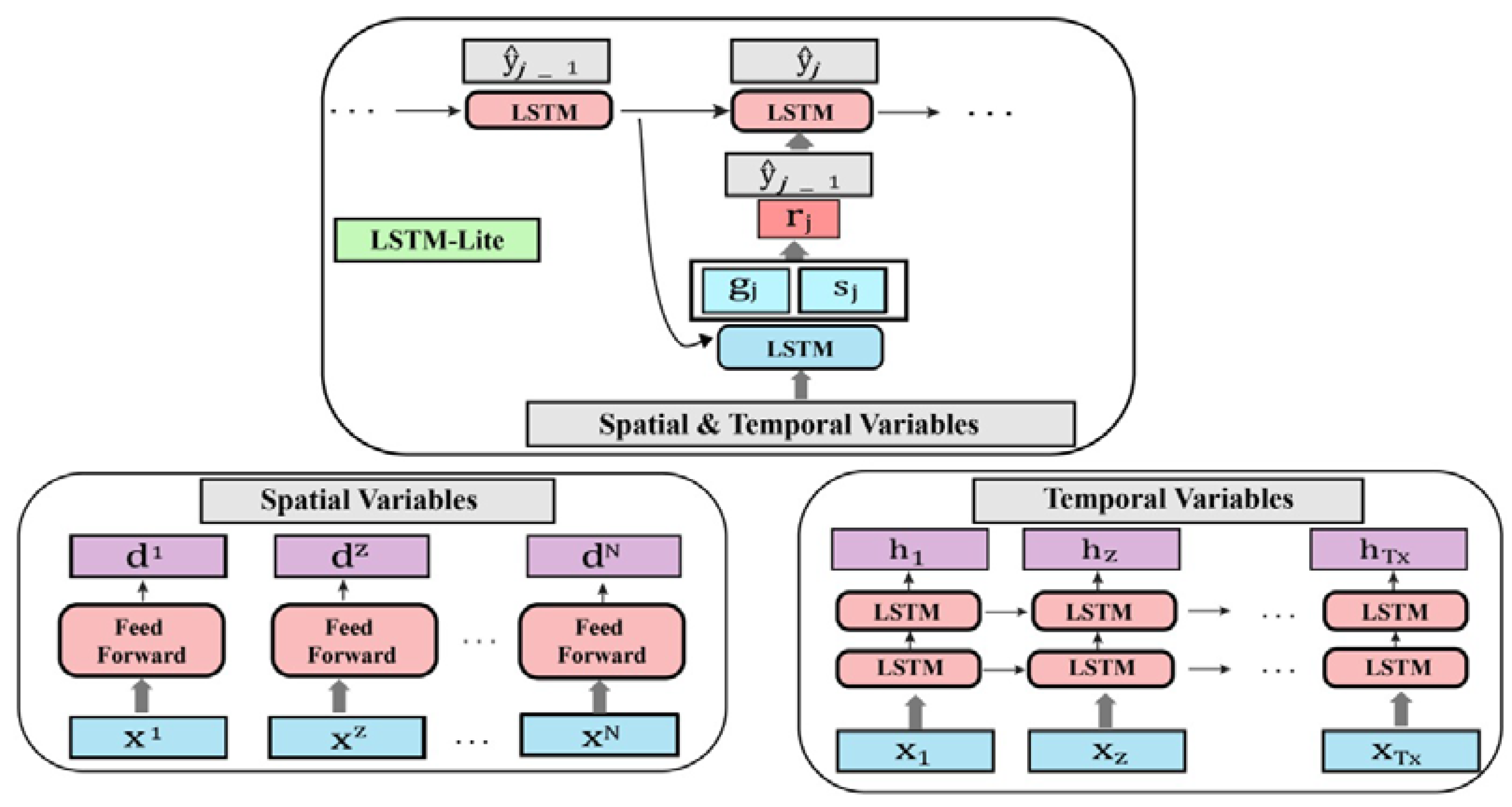
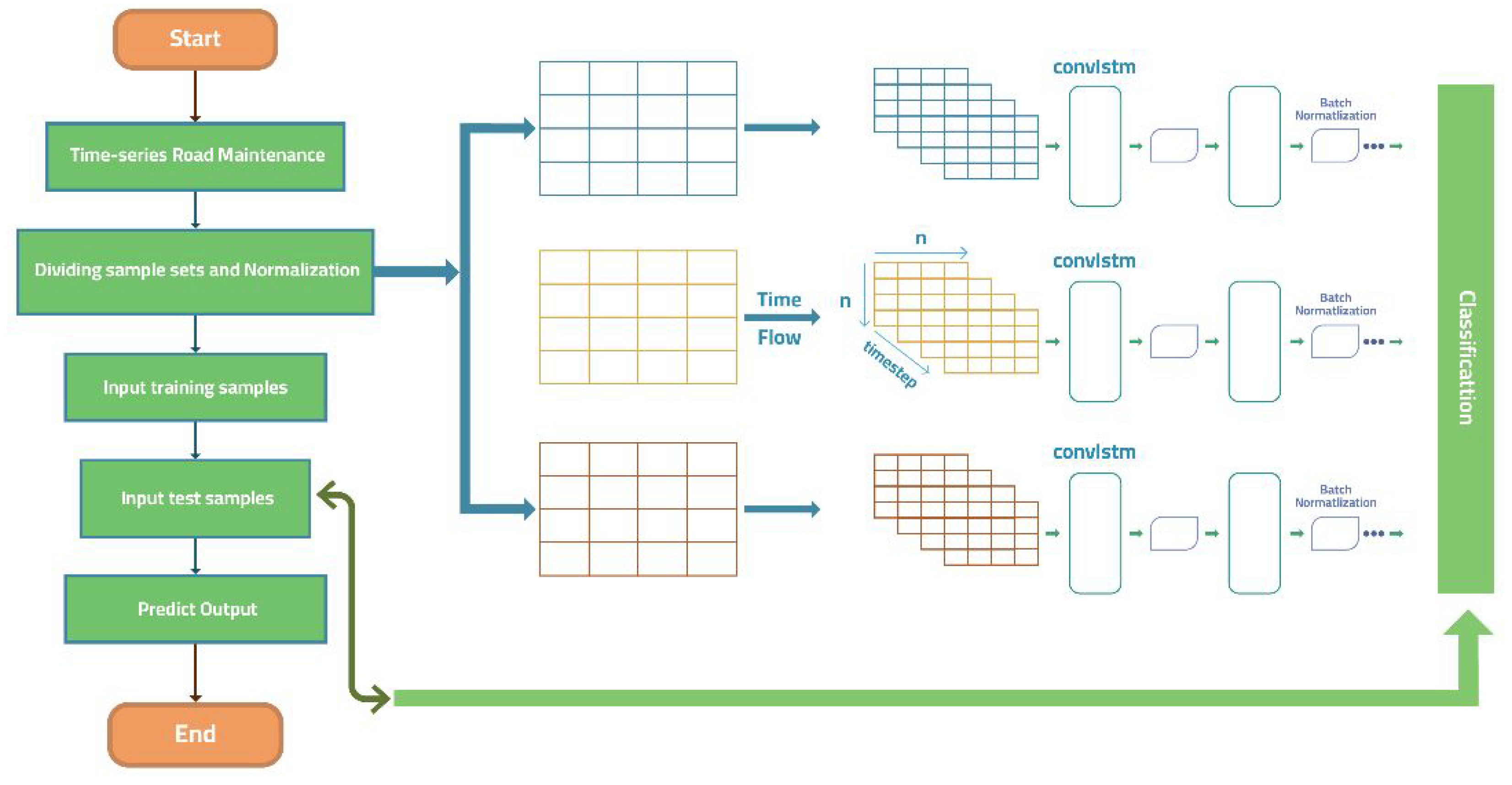
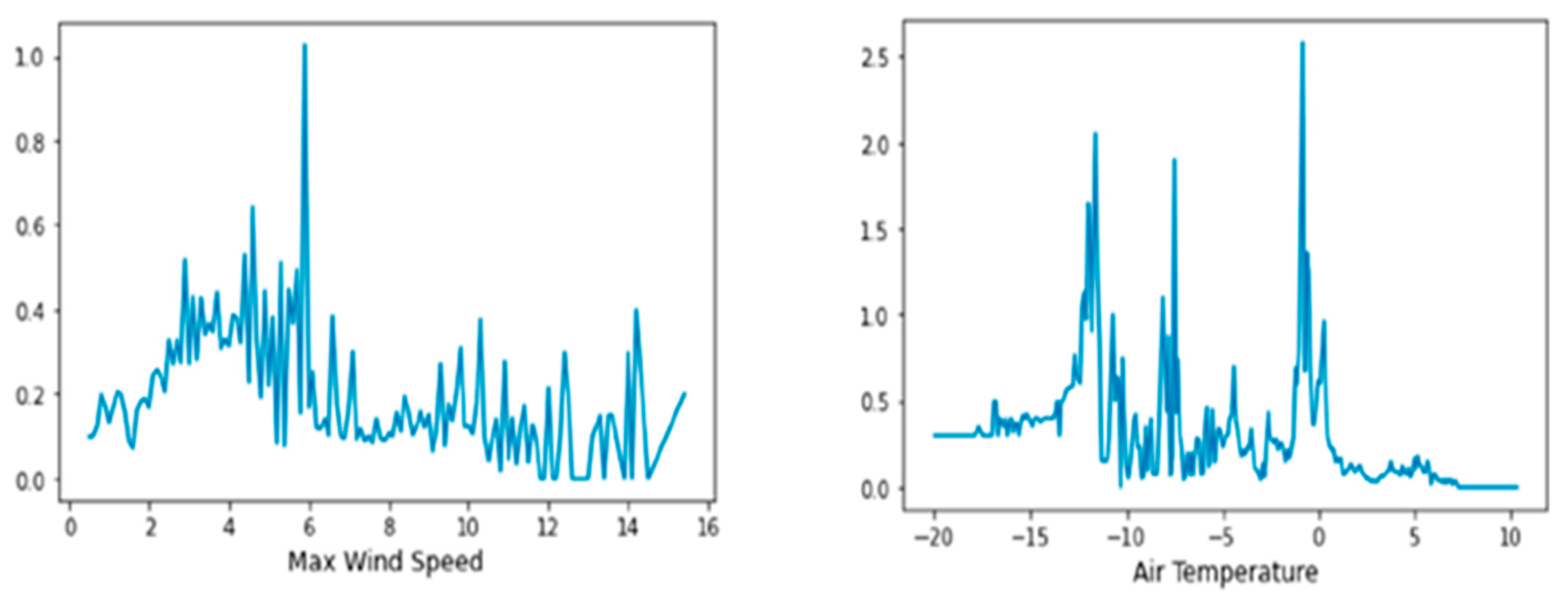
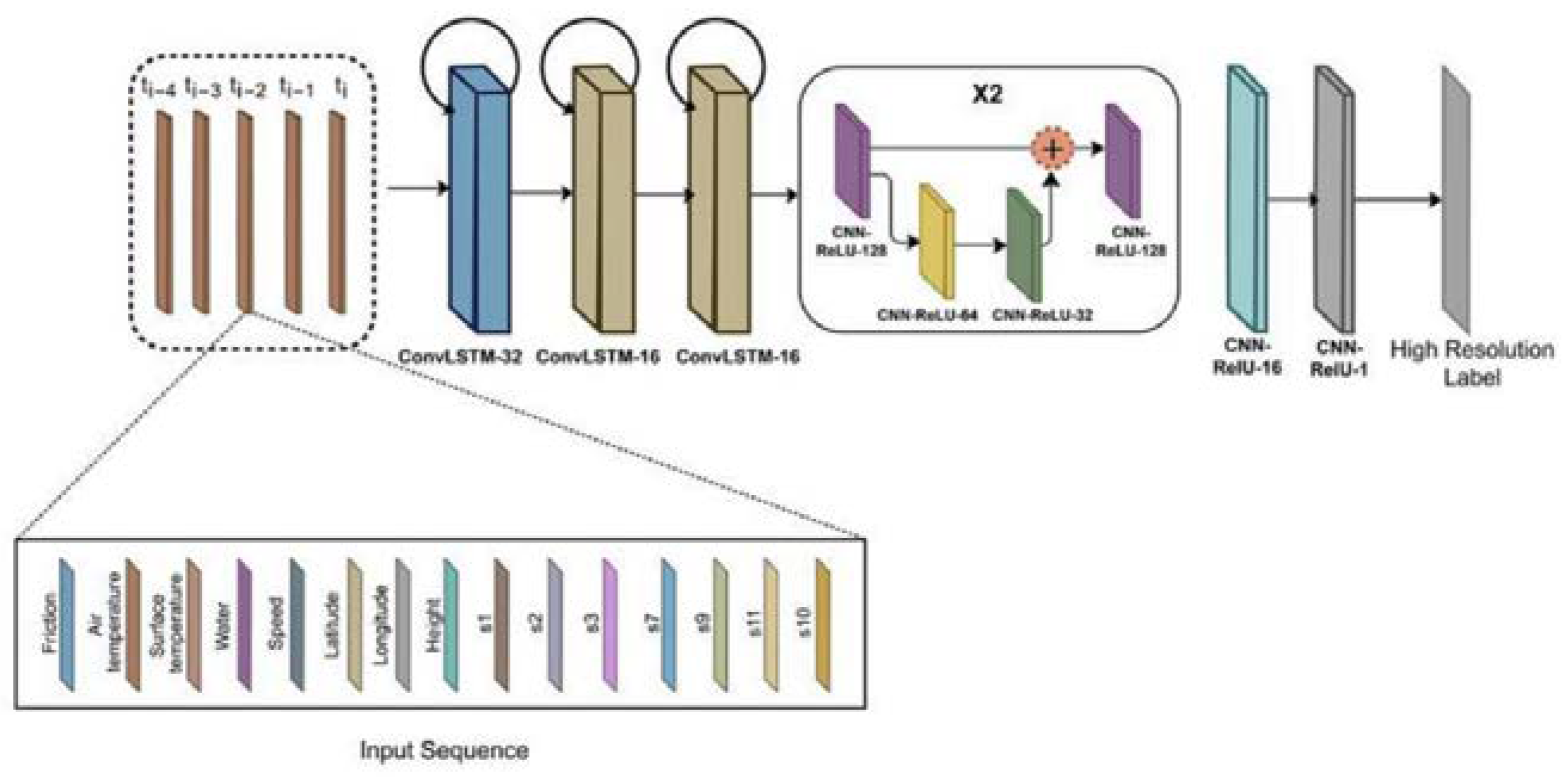
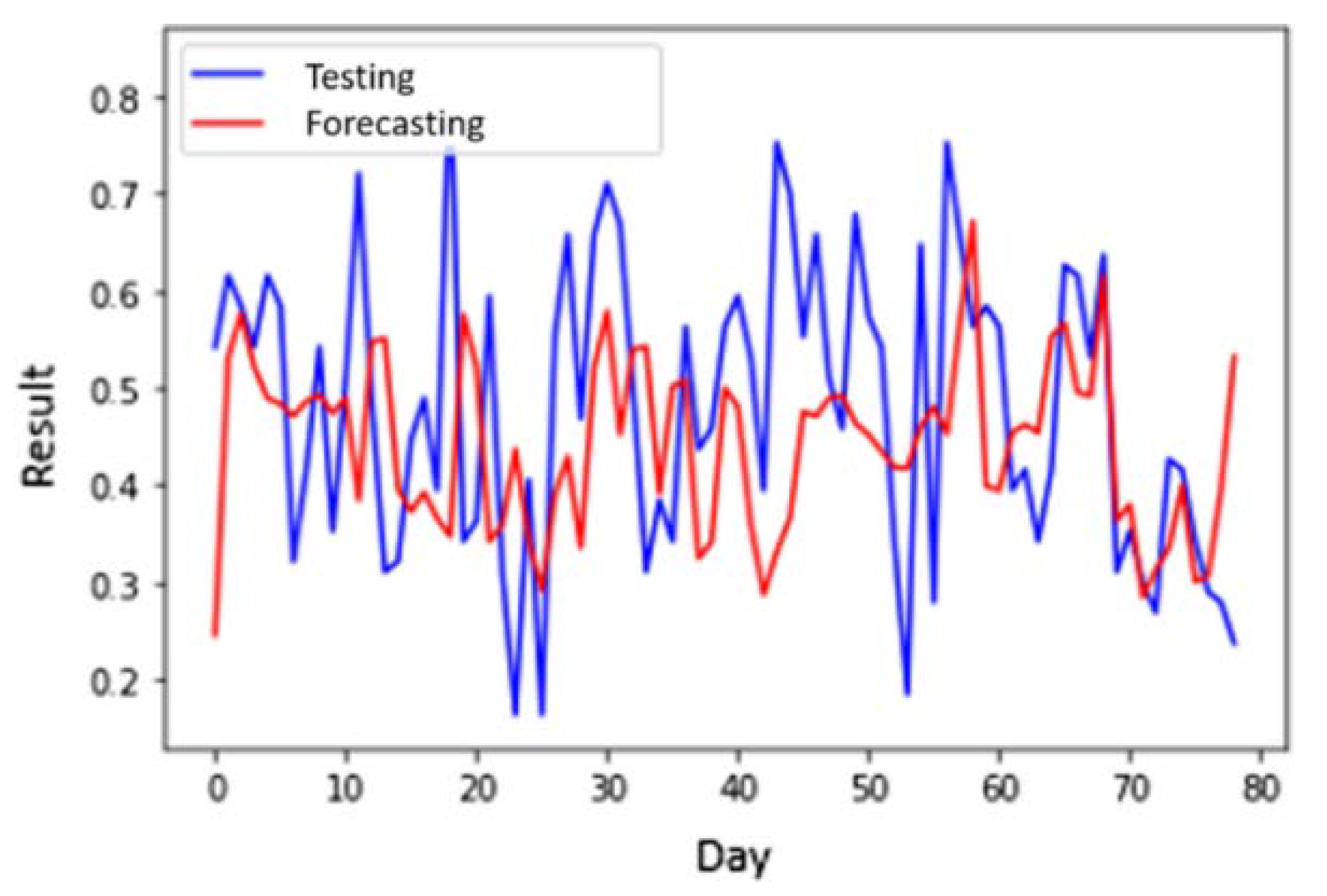
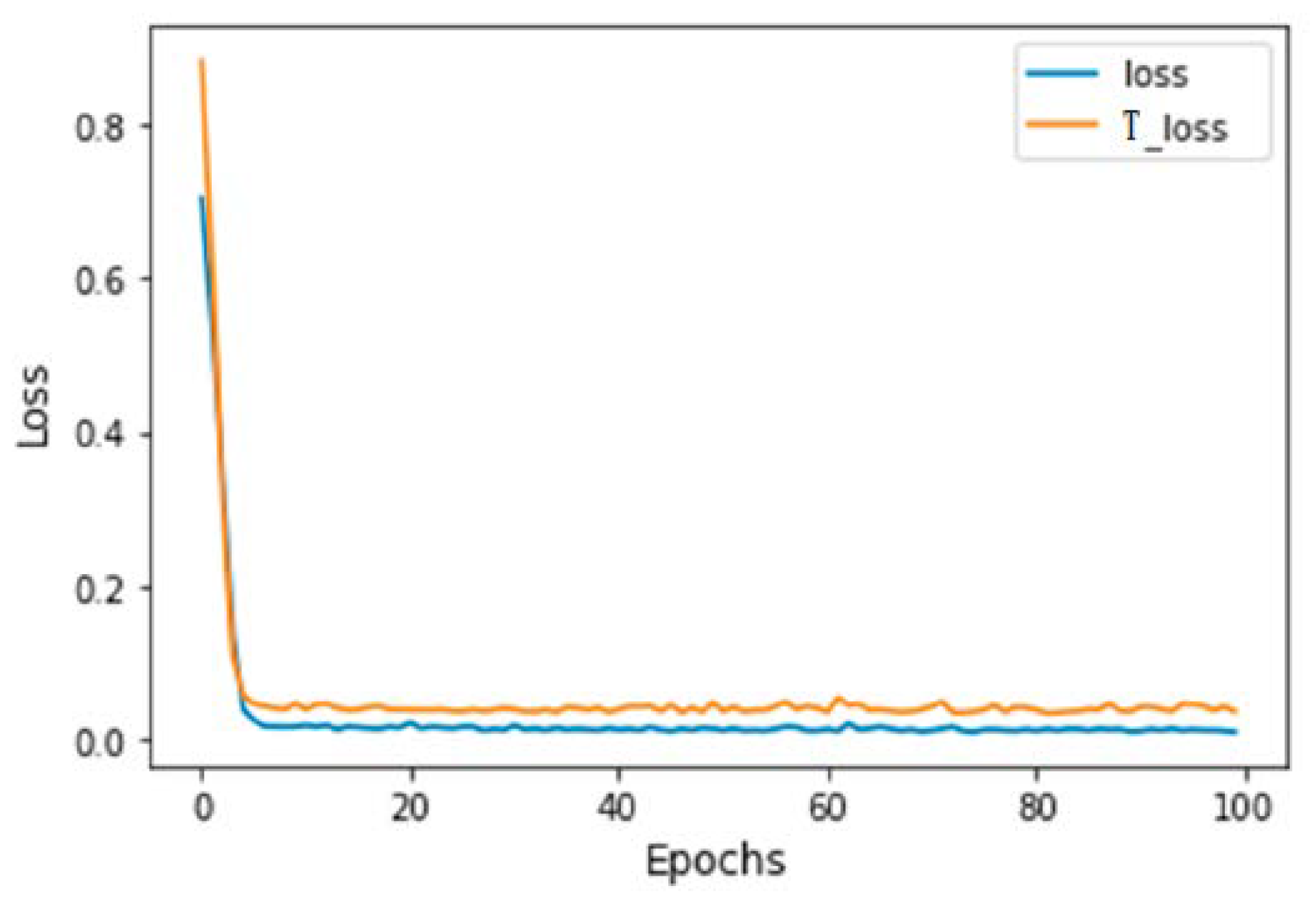
| No. of Ref. | Research | Method | Main Category |
|---|---|---|---|
| [44] | Identifying damage to infrastructure assets | CNN | Building |
| [45] | CNN | Road | |
| [46] | CNN | Water | |
| [37] | KNN | Bridges | |
| [47] | CNN | Power | |
| [48] | Timing of Maintenance and Rehabilitation | ML | Bridges |
| [41] | RL | Road | |
| [32] | RL | Road | |
| [43] | RL | Road | |
| [29] | GA | Road | |
| [22] | Performance Forecast | KNN | Road |
| [37] | ANN | Dam | |
| [49] | ANN | Sewer | |
| [50] | RNN | Power |
| Performance | RMSE | MAE | Average | time | |
|---|---|---|---|---|---|
| LSTM | Training | 4.04 × 100 | 5.43 × 100 | 7.78 × 100 | 6.2 |
| Testing | 3.44 × 100 | 4.53 × 100 | 6.99 × 100 | 6.3 | |
| RNN | Training | 0.9216 × 100 | 1.8921 × 100 | 3.81 × 100 | 2.5 |
| Testing | 0.8124 × 100 | 1.223 × 100 | 3.01 × 100 | 2.3 | |
| CNN | Training | 6.94 × 100 | 7.43 × 100 | 8.78 × 100 | 1.9 |
| Testing | 5.83 × 100 | 6.95 × 100 | 9.88 × 100 | 1.8 | |
| CONV-LSTM | Training | 1.52 × 10−1 | 0.43 × 100 | 1.65 × 100 | 1.5 |
| Testing | 1.31 × 10−1 | 2.12 × 10−1 | 5.27 × 10−1 | 1.6 | |
| RMSDC | Training | 0.0814 × 10−1 | 0.1721 × 10−1 | 0.9410 × 10−1 | 0.98 |
| Testing | 0.8813 × 10−1 | 0.1913 × 10−1 | 0.8812 × 10−1 | 0.99 |
| Performance | RMSE | MAE | Average | Time | |
|---|---|---|---|---|---|
| LSTM | Training | 2.4444 | 2.5225 | 2.78 × 100 | 5.2 |
| Testing | 1.5544 | 1.51228 | 5.99 × 100 | 5.5 | |
| RNN | Training | 3.1776 | 4.0786 | 4.81 × 100 | 5.5 |
| Testing | 3.1786 | 4.0795 | 4.01 × 100 | 3.7 | |
| CNN | Training | 2.1611 | 2.0650 | 3.78 × 100 | 1.4 |
| Testing | 2.1711 | 2.0660 | 2.88 × 100 | 1.5 | |
| CONV-LSTM | Training | 2.0800 | 2.0478 | 2.841 × 100 | 1.12 |
| Testing | 2.0900 | 2.0488 | 1.8812 × 100 | 1.2 | |
| RMSDC | Training | 1.2534 | 2.0459 | 2.26 × 100 | 0.65 |
| Testing | 2.0635 | 1.0559 | 2.17 × 100 | 0.72 |
Disclaimer/Publisher’s Note: The statements, opinions and data contained in all publications are solely those of the individual author(s) and contributor(s) and not of MDPI and/or the editor(s). MDPI and/or the editor(s) disclaim responsibility for any injury to people or property resulting from any ideas, methods, instructions or products referred to in the content. |
© 2023 by the authors. Licensee MDPI, Basel, Switzerland. This article is an open access article distributed under the terms and conditions of the Creative Commons Attribution (CC BY) license (https://creativecommons.org/licenses/by/4.0/).
Share and Cite
Elwahsh, H.; Allakany, A.; Alsabaan, M.; Ibrahem, M.I.; El-Shafeiy, E. A Deep Learning Technique to Improve Road Maintenance Systems Based on Climate Change. Appl. Sci. 2023, 13, 8899. https://doi.org/10.3390/app13158899
Elwahsh H, Allakany A, Alsabaan M, Ibrahem MI, El-Shafeiy E. A Deep Learning Technique to Improve Road Maintenance Systems Based on Climate Change. Applied Sciences. 2023; 13(15):8899. https://doi.org/10.3390/app13158899
Chicago/Turabian StyleElwahsh, Haitham, Alaa Allakany, Maazen Alsabaan, Mohamed I. Ibrahem, and Engy El-Shafeiy. 2023. "A Deep Learning Technique to Improve Road Maintenance Systems Based on Climate Change" Applied Sciences 13, no. 15: 8899. https://doi.org/10.3390/app13158899
APA StyleElwahsh, H., Allakany, A., Alsabaan, M., Ibrahem, M. I., & El-Shafeiy, E. (2023). A Deep Learning Technique to Improve Road Maintenance Systems Based on Climate Change. Applied Sciences, 13(15), 8899. https://doi.org/10.3390/app13158899








